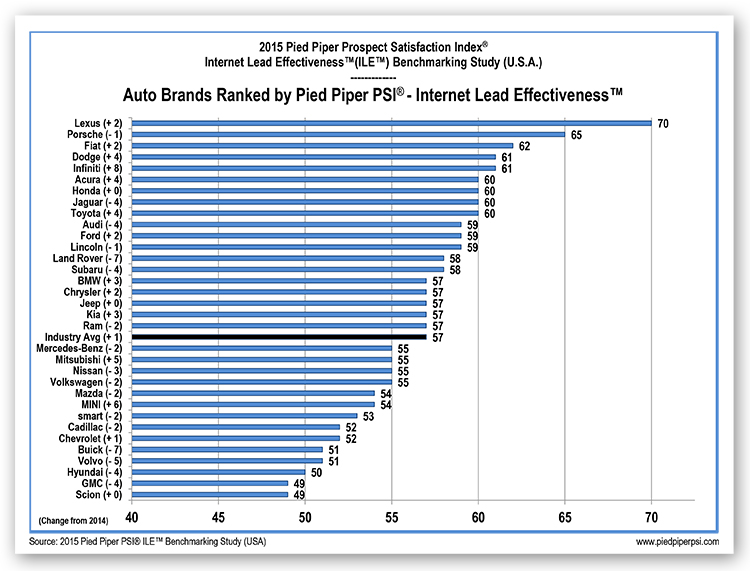Lexus dealerships respond best to customer Internet inquiries, even though Toyota’s luxury brand shows imperfections here and there.
That’s according to consultancy Pied Piper’s annual by-brand mystery-shopping study for its Internet Lead Effectiveness Index.
Lexus ranks first with a score of 70 (out of a possible 100), followed by Porsche at 65, Fiat at 62, Dodge and Infiniti both at 61 and Acura, Honda Jaguar and Toyota at 60.
Low scorers include GMC and Scion (49), Hyundai (50) and Volvo and Buick (51). This year’s industry average is 57.
Pied Piper’s mystery shoppers send emails containing specific questions. Those go to large and small dealerships nationwide. The firm measures how quickly the stores respond, if at all. In the latest study, 8% of inquiries received no response of any kind. That hasn’t changed in four years. For the index, it’s a cardinal sin.
The study also measures quality of responses and how quickly a salesperson tried to reach a shopper by phone. In addition to the index’s numerical scoring, individual auto brands receive letter grades in particular categories. Even top-scoring Lexus got a few Fs.

This is the seventh year of the Pied Piper Internet lead-effectiveness study. WardsAuto spoke with CEO Fran O’Hagan about the latest results. Here’s an edited version of the interview.
WardsAuto: Give some highlights.
O’Hagan: The most interesting thing is that this is still a part of the car business where there’s a lot of low-hanging fruit. It’s difficult to drive incremental sales, a part of the car business where some effort immediately pays off. Internet lead effectiveness drives incremental sales, yet there’s room for improvement.
Lexus is by far the best-performing brand, yet 16% of the time it got an “F” and 10% of the time a “D.” So that poor scoring affects one in four of customers who contact a Lexus dealership by email.
The industry-average score has improved. In 2011 it was 50. This year it’s 57. But if we look at individual measures, such as whether an inquiry received a response of any type, even a boilerplate auto response, one in 12 didn’t. That hasn’t changed since 2011.
WardsAuto: That would seem the easiest to fix.
O’Hagan: Sure. The question would be: Why isn’t it improving? Yes, there’s low-hanging fruit. Yes, by improving we easily sell more cars. Then why isn’t everyone trying to improve it? They are, but this is not easy. There are a lot of moving parts. It takes effort to develop a process that works, and then work the process.
We’ve also seen that the minute a manufacturer or dealer group takes their foot off the gas, it goes away. We have a front-row seat to that.
WardsAuto: Are we talking about basic human behavior of people backsliding if their work performances are not measured?
O’Hagan: Absolutely. If you stop measuring it, it will change.
WardsAuto: You said it’s not easy, but it would seem straightforward to come up with a process, especially if you can take an effective existing one, and then put it to work. What’s hard about that?
O’Hagan: A process is a process whether it is manual or automated. But it has to work correctly. In 2008, auto responders were still fairly new. We’d get responses from them saying: “Thank you for your interest in ‘insert model here.’” About one in 10 auto responders had that.
Even today, we see that sort of thing. Some automated systems are set up incorrectly, and then mistakenly indicate a response has been sent out when it hasn’t. When it’s set up wrong, it’s not working.
The Trick Box
WardsAuto: If you are dealership salesperson and there’s proof that if you respond quickly and appropriately to Internet leads and by doing that you’ll definitely sell more cars, why wouldn’t you adhere to the process?
O’Hagan: Here’s the trick box. Some dealerships use a round-robin process of handing out Internet leads to salespeople who are responsible for following up. That works at some dealerships. At far more, it doesn’t work.
The challenge is this: If I’m a salesperson who has one customer after another in front of me at the store, I’m not going to tell one of those customers to have a cup of coffee while I respond to Internet leads.
So those leads fall through the cracks. That’s why we see better performance from dealerships with BDCs (business development centers) that handle Internet inquiries up to the point of trying to set up an appointment.
But this is not rocket science. Your dealership sends out an immediate auto response. It’s like a print ad. It thanks you for inquiring, tells you a salesperson will be in touch quickly and gives three or four nuggets of why you’re talking to the right dealer. That’s followed up within 30 minutes with a personal email response that answers specific questions that are asked. The minute you send that, pick up the phone and call the person, if they’ve given you a phone number, and (our mystery shoppers) always do.
With Ford, dealerships always had a high attempt to follow up by phone. But what they do electronically leaves a bit to be desired, although it’s improved.
WardsAuto: What do you mean?
O’Hagan: We ask a specific question, like what would it cost to add a tow hitch. Industrywide, our question is answered a little less than half the time. Ford dealers answered it only 20% of the time, yet they’re good in following up by phone. They would say they did answer the question, but by phone, not electronically. Ideally, you want to do both.
The customer is saying, “There’s a reason I asked you in an email; I want it answered that way.” Dealers are saying they’d rather do it by phone because it’s a more powerful tool to get people into the dealership.
WardsAuto: Do you see an irony of using the power of the Internet to get them offline and on the phone?
O’Hagan: Yes. Most shoppers who receive that phone call are happy to get it. Some shoppers, for whatever reason, don’t want to be called. They want to email back and forth. But if I’m talking to you on the phone, what I want to do is get you into the dealership.
WardsAuto: So the Internet is a tool to redirect people to a different channel of communication?
O’Hagan: Interestingly, some people think the whole transaction will happen by email. Nine times out of 10, it will not. Maybe 50 years from now it will. But we see no sign of that happening in the near future. The vast majority still want to come into the dealership, even if they think they know exactly what they want.
WardsAuto: At what point does the Internet stop and the other things start?
O’Hagan: The most successful sales people use a soft close. They want to move it along to phone and to in-person as quickly as they can. But they’re judicious.
If you walk into a dealership and a salesperson rushes over and says, “Are you ready to buy right now?” you’d find that odd. You’d think the salesperson would want to build rapport and do some fact finding. You want to build a relationship, not just conduct a transaction.
Sometimes people forget that for the Internet. The salespeople jump to “Are you willing to buy today?” But you should use the same steps you’d use if you were with them in person.
Why Rush It?
WardsAuto: Why do some salespeople rush it online? Is it because they are not face-to-face with the customer, or do they regard the Internet as an immediate form of communications?
O’Hagan: It’s impatience. You still want to build rapport, sell yourself and sell the dealership.
WardsAuto: But are salespeople who rush it on the Internet misguidedly thinking that because of the immediacy of the Internet, they need to cut to the chase and skip the preliminaries?
O’Hagan: That’s often the case. Interestingly enough, some OEM employees feel that way. We see that with OEMs more often than with dealers, because if you are at a dealership and try that approach, it just doesn’t work. You fail, so you stop doing it. Some OEM people think the future of auto retailing is purely electronic. But that’s rare today.
WardsAuto: Why do OEMs think that? Is it wishful thinking?
O’Hagan: Maybe it’s just less of an appreciation of what really happens at retail.
WardsAuto: If a BDC employee fields the Internet inquiry and sets up the appointment, does the customer typically care if that staffer is not the one they will see at the dealership.
O’Hagan: You figure if a customer reaches out to a dealership with a question, and gets it answered, it doesn’t matter that you are dealing with someone else at the store.
WardsAuto: But if a BDC person really connects with a customer on the Internet and on the phone, and then the customer meets someone different at the dealership, isn’t that a disconnect?
O’Hagan: From what we see, perfection is the enemy of the good.
WardsAuto: What’s that mean?
O’Hagan: The bar is so low, if that’s what you are worried about as a dealer you’re outperforming 95% of the other dealers.
WardsAuto: Who does better, large or small stores?
O’Hagan: Large.
WardsAuto: Why?
O’Hagan: The volume of Internet leads coming to them forces them to have at least a rudimentary process for handling them. The smaller stores are the ones who try round robin, and have the individual inquiries falling through the cracks. But there are exceptions.
WardsAuto: Such as?
O’Hagan: Some smaller stores do great, but they are not forced to have a process like the big stores are.
WardsAuto: Regarding unanswered customer Internet queries, I think you pointed out that if every 12th customer who walked into the dealership was ignored, management would quickly address that.
O’Hagan: That’s crazy. That’s why Lexus got some “Fs.” There’s work to be done, but it’s worth it.





